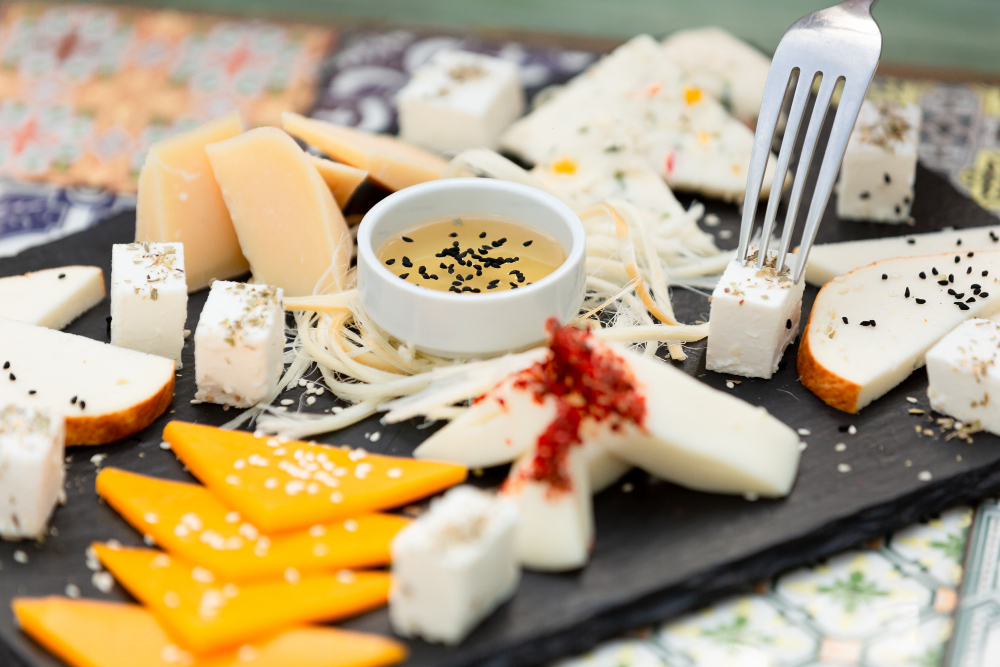Welcome to the world of French cheese, where tradition and innovation harmonize to create a symphony of flavours. Forget whatever you think you know about cheese. French one offers an entirely new level of gastronomic experience!
Each region brings unique terroir and artisanal techniques to this culinary art form. Let’s examine France’s cheese scene, a vibrant tapestry of flavours, textures, and traditions that have evolved over centuries.
The history and origin of French cheese
France’s passion for cheese traces back to antiquity. During the Roman era, it was already a staple of the French diet. Roman influences blended with Gallic culinary traditions, resulting in various cheeses enjoyed by different classes of society. As time progressed, other regions began specializing in unique types of cheese. It led to the rich variety we celebrate today.
In the Middle Ages, monks in monasteries started crafting what would become iconic French cheeses. They set new benchmarks for quality and flavour. During the Renaissance, cheese was present at royal tables, gaining the nobility’s endorsement as a fine food.
The French Revolution also left its imprint on cheese history. Revolutionary leaders declared cheese a ‘people’s food,’ making it more accessible across classes. The modern era has seen cheese evolve again, with international exports and Appellation d’Origine Contrôlée (AOC) recognition to certify the origins and production methods of different cheeses.
Cheese artisans in France hand down their craft from generation to generation. They maintain traditional methods while also embracing modern techniques. This combination ensures the highest quality, offering a bridge between the past and the present.
What types of French cheese exist?
In France, cheese falls into several distinct categories: soft cheese, hard cheese, blue cheese, and goat cheese are just a few. For instance, soft cheeses melt in your mouth. They release flavours that evoke the lush landscapes where their ingredients grow. Hard cheeses age for years, developing an unmatched taste and richness.
Here are some example you can try and enjoy:
- Soft cheeses: Brie, Camembert, Reblochon.
- Hard cheeses: Comté, Emmental.
- Blue cheeses: Roquefort, Bleu d’Auvergne.
- Goat cheeses: Chèvre, Valençay.
These categories have unique characteristics, inviting you to embark on a flavorful journey across the diverse cheese landscape. Each type serves as a culinary emblem of its region, capturing its unique terroir!
Regional specialties: What you should know
France’s geography significantly influences its cheese production. The mountainous regions of the Alps and Pyrenees lend themselves to producing hard cheeses. At the same time, the fertile pastures of Normandy are the birthplace of many creamy delights.
Breton farmers produce fantastic goat cheeses from the region’s temperate climate and lush pastures. In the south, the bold flavours of blue cheese reflect the character of the rugged landscape.
What should you know about cheese and wine pairing?
Pairing French cheese with wine is an art in itself. The tannic nature of red wines balances the creaminess of a soft cheese like Brie. A white wine’s crispness might complement a strong blue cheese like Roquefort. Even the sparkling bubbles of Champagne can uplift the flavours of a subtle goat cheese.
Here are some more pairings to consider:
- Camembert with Pinot Noir. The light, fruity notes of Pinot Noir blend well with the creaminess of Camembert.
- Comté with Chardonnay. The full-bodied richness of Chardonnay pairs beautifully with the nutty flavours of aged Comté.
- Chèvre with Sauvignon Blanc. The sharp acidity of Sauvignon Blanc makes it an ideal match for the tangy goat cheese.
French cheese is more than just a food. It is a cultural experience and gastronomic journey offering many flavours and textures. Whether you are a novice or a connoisseur, the world of French fromage invites you to explore, taste, and savour each masterpiece that comes your way!
If you have any questions, our team is always here to help. Feel free to contact us, and we will get back to you as soon as possible with the information you need.
